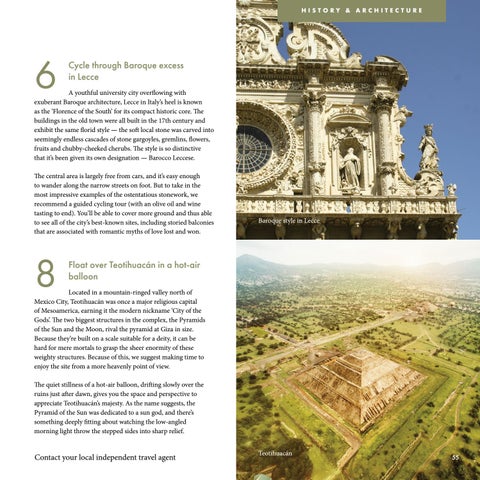HISTORY & ARCHITECTURE
6
Cycle through Baroque excess in Lecce
A youthful university city overflowing with exuberant Baroque architecture, Lecce in Italy’s heel is known as the ‘Florence of the South’ for its compact historic core. The buildings in the old town were all built in the 17th century and exhibit the same florid style — the soft local stone was carved into seemingly endless cascades of stone gargoyles, gremlins, flowers, fruits and chubby-cheeked cherubs. The style is so distinctive that it’s been given its own designation — Barocco Leccese. The central area is largely free from cars, and it’s easy enough to wander along the narrow streets on foot. But to take in the most impressive examples of the ostentatious stonework, we recommend a guided cycling tour (with an olive oil and wine tasting to end). You’ll be able to cover more ground and thus able to see all of the city’s best-known sites, including storied balconies that are associated with romantic myths of love lost and won.
8
Baroque style in Lecce
Float over Teotihuacán in a hot-air balloon
Located in a mountain-ringed valley north of Mexico City, Teotihuacán was once a major religious capital of Mesoamerica, earning it the modern nickname ‘City of the Gods’. The two biggest structures in the complex, the Pyramids of the Sun and the Moon, rival the pyramid at Giza in size. Because they’re built on a scale suitable for a deity, it can be hard for mere mortals to grasp the sheer enormity of these weighty structures. Because of this, we suggest making time to enjoy the site from a more heavenly point of view. The quiet stillness of a hot-air balloon, drifting slowly over the ruins just after dawn, gives you the space and perspective to appreciate Teotihuacán’s majesty. As the name suggests, the Pyramid of the Sun was dedicated to a sun god, and there’s something deeply fitting about watching the low-angled morning light throw the stepped sides into sharp relief.
Contact your local independent travel agent
Teotihuacán
55












